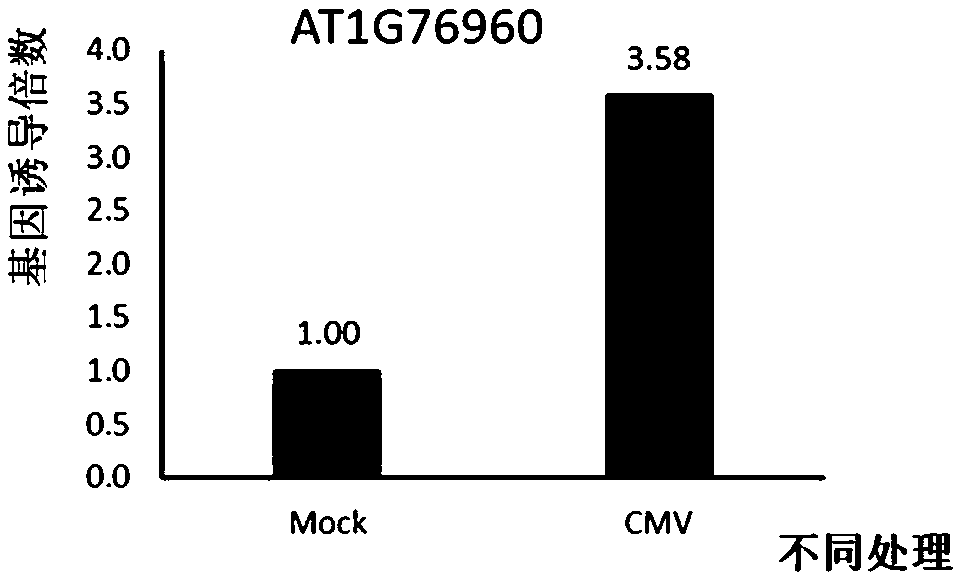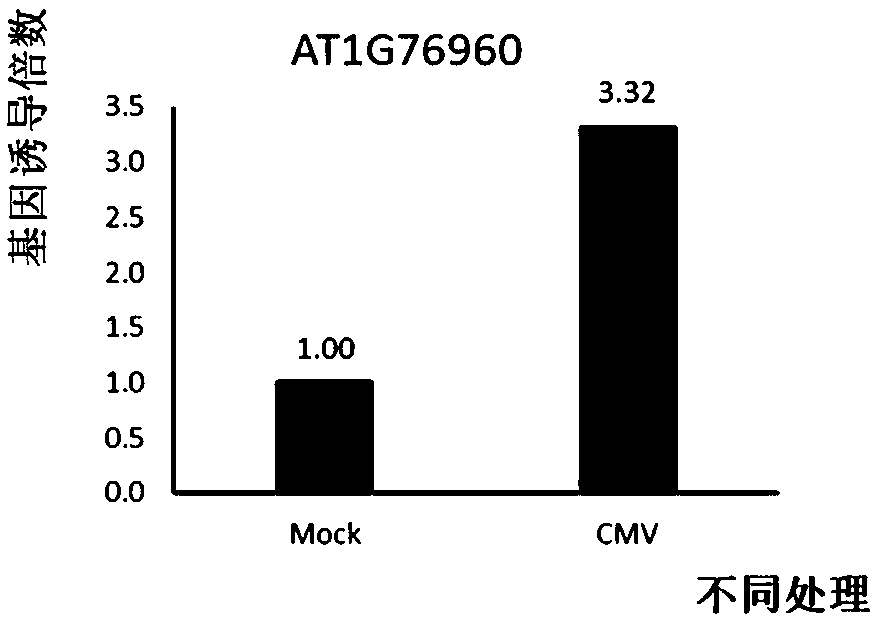Antiviral polypeptide and preparation method and application of antiviral polypeptide
An anti-virus and polypeptide technology, applied in the biological field, can solve the problems of difficulty in obtaining mutants with loss of function, no anti-viral effect polypeptide, short coding gene length, etc., to achieve plant virus immune defense and effective plant virus immune defense , the effect of reducing the amount of infection
- Summary
- Abstract
- Description
- Claims
- Application Information
AI Technical Summary
Problems solved by technology
Method used
Image
Examples
Embodiment 1
[0052] Obtaining and expression vector construction of embodiment 1 AtVISP1 gene
[0053] (1) Acquisition of AtVISP1 gene
[0054] In this experiment, transcriptome sequencing was performed on Arabidopsis plants inoculated with cucumber mosaic virus (CMV) for one week, and the results were analyzed and it was found that the expression level of AT1G76960 was up-regulated to 3.58 times after inoculation with the virus (eg figure 1 shown), and then verify the result with realtime (such as figure 2 shown), the gene was named AtVISP1 gene, and the synthetic amplification primers were designed and synthesized according to the gene sequence.
[0055] According to the online website (http: / / www.cbs.dtu.dk / services / SignalP / ) to analyze the structural characteristics of AtVISP1 protein, it is shown that AtVISP1 contains 52 amino acids, of which 1-26 amino acids are part of the signal peptide (AtVISP1-S), The 27-52 amino acids behind are the mature peptide (AtVISP1-M) part, such as ...
Embodiment 2
[0060] Example 2 Detection of Antiviral Effect of Transient Expression of AtVISP1
[0061] (1) Transform the pMDC32-AtVISP1 vector constructed in Example 1 into Agrobacterium EHA105, using SEQ ID NO.18 (5'-AGGCGCGCCATGAAAAGTTCATCG GAGCTCC-3') and SEQ ID NO.20 (5'-GAGCTCCACCGCGGTGGC GGCCGC-3' ) Perform colony PCR identification and sequencing verification on the transformed strain, obtain a single positive Agrobacterium colony transformed with pMDC32-AtVISP1, and name it pMDC32-AtVISP1 strain. Inoculate the freshly activated pMDC32-AtVISP1 strain and the suppressor P19 strain into 3ml LB medium (containing 0.1mg / ml kanamycin and 0.025mg / ml rifampicin), and culture overnight at 28°C and 220rpm until OD 600 About 1.0, centrifuge at 4000rpm for 10min, discard the supernatant, and suspend the pellet in 2ml suspension buffer (10mM Morpholineethanesulfonic acid, 10mM MgCl 2 , 150μMAcetosyringone), measure OD 600 , adjust the OD of pMDC32-AtVISP1 strain with suspension buffer 600 0...
Embodiment 3
[0064] Example 3 Preparation of AtVISP1-M in Yeast
[0065] (1) Codon preference optimization of AtVISP1-M gene
[0066] Using the codon preference optimization program of the http: / / www.jcat.de / website, the nucleotide sequence encoding the mature peptide AtVISP1-M of the Arabidopsis AtVISP1 gene was optimized according to the yeast codon preference, and the optimized sequence For SEQ ID NO.21ATGTTGCC AGGTACTCCATATGGTGGTCCAGGTCCATATCCAAGATCTTATCCAGTTTGTTATCCACCATATTGTAGACCA, the AtVSP1-M gene fragment was synthesized by TSINGKE.
[0067] (2) Amplification of AtVISP1-M gene and construction of yeast expression vector
[0068] Using the synthetic fragment SEQ ID NO.21 as a template, with SEQ ID NO.22 (5'-ATAAGAATGCGGCCGCATGTTGCCAGGTACTCCATATGG-3', containing Not I site) and SEQ ID NO.23 (5'-CTAGTCTAGATGGTCTACAATA TGGTGGATAACAAAC-3', containing Xba I site) as a primer, PCR amplification with PrimeSTAR HSDNA polymerase (TaKaRa) to obtain a DNA fragment with a length of 81bp, th...
PUM
 Login to View More
Login to View More Abstract
Description
Claims
Application Information
 Login to View More
Login to View More - R&D
- Intellectual Property
- Life Sciences
- Materials
- Tech Scout
- Unparalleled Data Quality
- Higher Quality Content
- 60% Fewer Hallucinations
Browse by: Latest US Patents, China's latest patents, Technical Efficacy Thesaurus, Application Domain, Technology Topic, Popular Technical Reports.
© 2025 PatSnap. All rights reserved.Legal|Privacy policy|Modern Slavery Act Transparency Statement|Sitemap|About US| Contact US: help@patsnap.com



